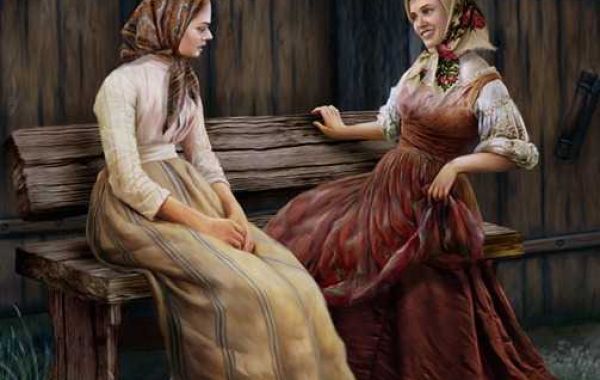Hello, I’m glad to present my article. As a professional writer, I constantly write lots of blogs and topics on a variety of topics and welcome you to read many more of them on my website https://best-essays-cheap.com/
Enjoy your reading!
The Russian writer A.Chekhov entered the world literature as an unsurpassed master of a short story. His work belongs to such a literary movement as classical realism of the second half of the nineteenth century, which influenced the writer's choice of certain problems, themes, subjects, characters, and artistic details. Realists are characterized by a special way of seeing and interpreting the world and a person when even a minor detail and concise plot can tell a lot about the life of the characters. The short story “Peasant Wives” (1891) belongs to the early period of literary activity of Chekhov; it is very short and has a simple plot. Nevertheless, the author was able to tell about the tragedy of the life and death of a young woman to show the worthlessness and baseness of the moralizing heroes who were involved in her sad fate. The author shows the tragic fate of women in the conditions of the patriarchal Russian village in the late nineteenth century through the plot, theme, and characters of this short story.
The plot of this literary work seems simple at first glance. However, by its structure, this story consists of several plot lines. The first one is connected with the events from the past life of the characters. We learn about these events from the narrator Matvey Savitch, who in this case is a young man. The author avoids expressing his views on events in the story. Instead, other characters do it. However, it becomes clear to the reader that the author condemns these persons and does not share their worldview. The owner of the house, Filip Ivanovich Kashin, nicknamed Dyudya asks Matvey Savitch to tell the story of Kuzka with whom he stayed at his house. Here begins the first story. The reader learns from the conversation of two persons about the tragedy of a young woman Mashenka who married without love and then lived with Matvey Savitch for a while. After Mashenka’s husband returns from the army, Matvey Savitch cynically declares trying to get rid of the woman who bothered him: “Man and wife are one flesh. We have sinned, ‘I said,’ you and I, and it is enough; we must repent and fear God” (Chekhov, 1891). After a while, Mashenka’s husband mysteriously dies. A young woman was accused of poisoning him and exiled to Siberia, but on the way she died. No one was punished for her death, and she herself became the object of cynical and insulting evaluations from the narrator. Her son becomes an orphan and the main character takes him to himself and even says that he wants to help him in his future life. The second plot line is connected with the events unfolding in front of the reader. These are the stories of two women, Sofya and Varvara, who live in this house. They also got married without love and, like Mashenka, were deeply unhappy women. Thus, these storylines are closely related.
Thanks to such a framed plot of the story, the author managed to touch on a very important theme – a difficult and tragic life of a woman who is deprived of the right to happiness and a decent life. In the patriarchal world of the Russian countryside, a woman is constantly humiliated and deprived of the right to vote. Women are surrounded by cynical and immoral people who habitually moralize for themselves without even thinking that they are the cause of the misfortune of others. These women can be humiliated, constantly reproach something. “Live like a dog and you must die a dog's death,” cynically says about the death of Masha the owner of the house Dyudya. No one even tries to understand these women, but the worst thing is that none of the men was capable of compassion towards them. The author makes it clear that the cynicism and immorality of male heroes are the cause of the tragic fate of women. This theme is enhanced by Chekhov on the example of Sofia. The heard story makes her think about this miserable and doomed life with an unloved husband. She even has a thought to poison her husband and shares it with Varvara. In such difficult circumstances, she thinks about committing a crime and even murdering her husband. Of course, the motive of murder, which runs throughout the whole story, gives the theme of this literary work a truly tragic character. The theme of the unhappy life of women is complemented and reinforced by the theme of the tragic fate of their children. This is shown exactly on the character of Kuzka, who is also awaited by an unfortunate fate.
The story depicts several characters. The main character Matvey Savitch personally does not see anything reprehensible in his actions. Moreover, he sincerely believes that it is he who can condemn the woman seduced by him. His morale looks cynical although he does not even notice it. Separate details of the author draw the image of his adopted son. One minor detail – “his elbows looked like knees” (Chekhov, 1891) – tells how thin he is and causes compassion by his appearance. His story, feelings, the way he lives now and what he will have later – everything can be seen in one minor episode when the boy lost his hat and tried to find it under the scolding of the benefactor. Panic fussy movements and the expression of horror on his face which replaced the stupid submissiveness and indifference – that is the psychological description of the boy. In fact, he is also humbled and unhappy as the women in the story. The characters of women seem to be in the background: their presence is not as noticeable as the presence of men. At the same time, their fate is the central node of the story. Even the title of the story suggests that the fate of women draws the author’s attention most of all. It is not surprising that critics say that the fate of women has always interested the writer (Whyman, 2011, p.125). Their portrait characteristics are very concise. Sofya, for example, is “a handsome young woman, smart and buxom” (Chekhov, 1891) aND Varvara is “a plain, ailing woman” (Chekhov, 1891). Sophya honestly admits that she loves to flirt with men, her husband tired, and she does not love him. Their dialogue at the end of the story is the culmination when it becomes clear that both OF these women are deeply unhappy, and their life is devoid of any meaning. Instead, the author makes it clear that in the heart of these women there is a growing protest because of their humiliating position. This protest can be seen in Sophia’s riotous life and her willingness to commit a crime against her husband.
In conclusion, the simple plot unfolds in a broad picture of life covering many lives and telling about the fate of women in Russia. Chekhov succeeds through a seemingly not eventful plot to create a holistic picture of the life of his characters, where the place of a woman is strictly determined by the patriarchal value system. He does this not expressing directly his position, but through the plot, the system of characters and some details that have an important meaning in the context of the work.
References








